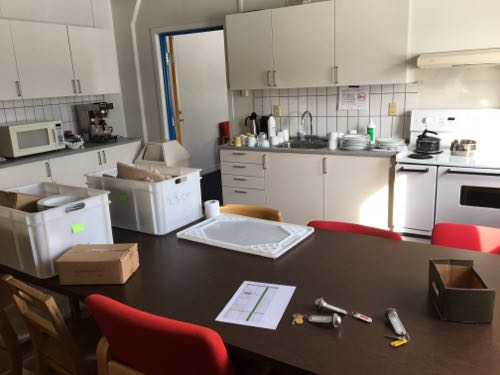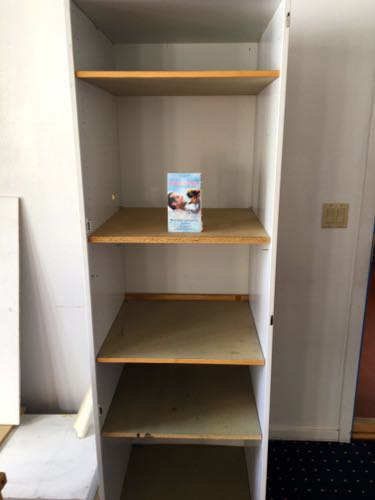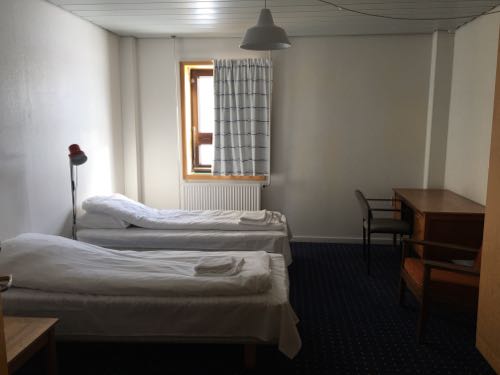Kanger First Full Day
So far things are going well. The morning got off to a slow start. Getting your footing at a new airport takes some time. There are many procedures that need to be followed and it takes awhile for people to get accustomed to the new schedule. The official time in Kangerlussuaq is an hour later than it was in Thule. Also, we start our missions a half hour later here in Kanger. Even though I didn't actually sleep in. One would think this would make everyone move faster, getting some extra time in the morning but it was the opposite. I was feeling a little lazy this morning, but I did not let that get in my way too much.
Before even reaching the plane this morning I went to the weather office. There I met Anna who is a weather genius. To predict weather one not only needs to know the maps and readouts but they need to know the features of an area. As we all know weather is hard to predict and varies throughout the day. Missions are decided by the weather and how much clear data the instruments will receive. The weather in Kanger is much touchier than in Thule. The night before a mission, several flight plans are discussed. Once at the wether station, John Sontagg (Nasa Engineer and Scientist) and Scott Farley (pilot) decide the mission for the day based on optimizing time spent on mission and how much clear usable data can be collected. Today we are flying the Southeast Coastal Mission because the weather for that area was clear and data collection would be high. Weather permitting, the team will fly all of the required flights out of Kanger. There is no set schedule, just set missions. The missions can be shuffled like a deck of cards, stacking the deck with the mission that has the best results going to the top of the deck. Weather is the temporary atmospheric conditions of an area in a specific place and time. It is always changing and only somewhat predictable. There are many factors that go into weather prediction and getting the entire picture takes an expert. Weather is all about forming a hypothesis of what you think may occur and then waiting to see if your hypothesis is accepted or rejected.
Today's flight was extremely bumpy. I was not a happy camper at first. But I didn't get sick! That is the first thing most people think as soon as they hear the words bumpy flight! No, I'm upset because like in all planes, the passengers safety comes first so when it's bumpy we are not allowed to stand up. During the first half of the day, we were flying over canyons and looking at terrain both inside and at the top of the canyon, and I missed it! I had to sit in my seat. I could watch it from my computer because the plane's camera was taking photographs but I couldn't see with my own eyes or take my own pictures. Now it is much calmer but we are flying over flat white ice. There are snow covered mountains off in the distance and it's pretty but it is not as exciting as this morning's terrain. On the bright side I did get to experience something new. I wore my crew headset the entire time and listened as the crew talked about all of the readings they were taking and the glitches that occur mid-flight. One of the radar systems was not working correctly during the flight so the crew had to wait until it was safe. Then they opened up a board in the floor of the plane to see if they could fix the problem. I am always shocked how quickly the scientists and engineers handle problems aboard the plane. They all work as a team. Even if the problem is with another person's system, the team pulls together to help out.
Today's Science Lesson
Looking at the weather is essential to a successful IceBridge Mission. As I mentioned before, every night there is a meeting to discuss the next day's mission. Several plans are considered. One mission is decided upon as the main goal for the day but backups are always needed. The next morning the weather is checked. The amount of clouds and where they appear in the sky is taken into account. Today there were cirrus clouds in the area we were surveying. Cirrus Clouds are high altitude clouds made of ice crystals. The plane flies low and slow so it was no problem to fly under the clouds. Wind speed and direction are also taken into account along with the pressure systems. Winds always travel from high to low areas of pressure. High pressure is usually associated with good weather, while low pressure system is usually associated with bad weather.
Air cools as it rises, which can cause water vapor in the air to condense into liquid water droplets, sometimes forming clouds and precipitation. Rising air is moist air and descending air is dry air. Low pressure air is forced up while high pressure air is forced down. This air movement allows scientists to look at the different pressure systems and predict whether it will be a clear day or a day with precipitation.
Leaving Thule Video and Our New Lodgings
I didn't get great pictures on the plane today it was very bumpy but here is a video about us leaving for Kanger and some pictures of our new lodgings. Tomorrow I will post some awesome ice pictures.





Comments